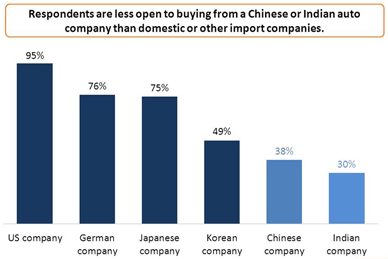New Automakers on The Block - Indian and Chinese Automakers Must Overcome Obstacles to Gain Market Share Among American Consumers
Only one-third of potential buyers open to Indian and Chinese manufacturers, compared to 95 percent for US manufacturers
NEW YORK, August 18, 2011 – As a wave of new models from Chinese and Indian auto manufacturers, including BYD, Mahindra and Tata, are poised to debut in the United States in the coming months, researchers from GfK Automotive found that significant barriers exist for these automakers to gain market share among American consumers.
GfK’s Barometer of Automotive Awareness and Imagery Study found that Chinese and Indian automakers could face a similar purchase consideration curve to Korean vehicles when they launched in the US In that case, it took more than 15 years for consumers to significantly increase their consideration to purchase Korean vehicles.
GfK’s study found that approximately one-third of consumers intending to purchase a vehicle are open to a Chinese (38 percent) or Indian (30 percent) manufacturer, compared to 95 percent of consumers open to purchasing from a US automaker.


"When a relatively unknown auto brand enters the market, potential buyers are going to have some initial scepticism without a frame of reference into the company’s history and differentiators from other brands,” said Don DeVeaux, managing director, GfK Automotive. "Quality and repair support are critical factors that potential buyers evaluate before purchasing a new vehicle, and without an established history in the United States, Chinese and Indian manufacturers need to overcome the lack of knowledge of their brands among potential new buyers.”
The openness to purchasing a Chinese and Indian vehicle is highest among Gen Y consumers, with 52 percent saying they are open to a vehicle from a Chinese automaker and 41 percent saying they are open to a vehicle from an Indian automaker. Openness is lowest among baby boomers, 29 percent of whom said they would be open to purchasing from a Chinese manufacturer and 22 percent said they would purchase from an Indian automaker.
"For Indian and Chinese auto manufacturers to accelerate the adoption curve and build loyalty quicker than Korean automakers did, they must hit the ground running and communicate their story to potential buyers,” said DeVeaux. "They need to make consumers comfortable with the brand and secure in their purchase decision by providing their proof points for quality, customer support and technology, as well as demonstrating their commitment to innovation.”
About GfK’s Barometer of Automotive Awareness and Imagery
The GfK Barometer of Automotive Awareness and Imagery Study (Image Barometer) is a comprehensive look at key measures of automotive brand equity on a segment-by-segment basis. The Image Barometer process probes into the deep structure of automotive consumers’ attitudes, opinions and perceptions of all the vehicles within each carefully defined segment. It is based on a blended online panel of new US vehicle intenders, balanced according to geography, socio-economic characteristics, and household composition as well as to make/model share of new vehicle intentions.
The Image Barometer has been conducted continuously since 1982. It is fielded quarterly, with sample sizes of 450 for make segments and 300 for model segments. This press release is based on data from Q4 2010.
About GfK Automotive
For nearly 30 years, GfK Automotive has been the preeminent provider of product, brand and consumer research and consulting to the global automotive industry. Counting most major Asian, European, and North American carmakers among its client base, GfK Automotive research consultants deliver integrated information and insights to the automotive community.

